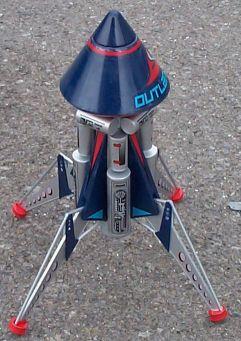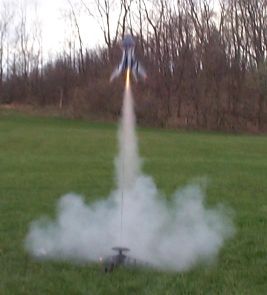| Construction Rating: | starstarstarstarstar_border |
| Flight Rating: | starstarstarstarstar_border |
| Overall Rating: | starstarstarstarstar_border |
| Manufacturer: | Estes  |

Brief:
Next generation Mars Lander.
Construction:
The kit includes:
- 2 BT-50 (one long, one short)
- 1 BT-20
- 1 large blow molded plastic piece from which you cut the nose cone, ascent module and nozzle
- 2 die-cut paper sheets
- 2 die cut balsa sheets
- 18" parachute
- Sticker type decal sheet
- Typical Estes materials including engine mount
I bought this kit because I was looking for a more challenging build. This kit does not disappoint. The kit should be rated level 5 difficulty and not level 3. In the "good old days", I built a few level 4 kits (Mars Snooper II, Orbital Transport) and this kit has them beat in terms of difficulty.
There are some definite issues with the instructions. Most obviously, when constructing the engine mount, there is a 2" long pre-cut wooden dowel that is used to align the rings that hold the landing gear in place. You will find that this dowel is too long and must be trimmed.
I encountered some other minor problems when building. One of the fuel tanks at the top of the rocket would not lay flat because of the launch lug. I corrected this by notching the fuel tank to fit around the launch lug. On my kit, the plastic on the ascent module was particularly thin. I had to reinforce the edge with epoxy to give it sufficient strength.
In general, the quality was very good. The balsa was top notch. The die cut of the balsa and paper parts was very good. I had one circular fuel tank cap that was slightly out of round. Easily fixed with a little sanding.
To really get the model to look good, there are some extra steps you might want to take. Most importantly, you should sand the root edge of the "fin guides" round (concave) to match the curve of the body tube.
As always, read the instructions thoroughly. Make sure you understand the steps before building. Test fit your parts. This is especially important with a kit of this complexity.
Finishing:
If you want to finish the rocket as shown on the package (as I did), you will
need to paint the rocket as you build. The instructions will tell you when to
paint the various assemblies during construction. If you go this route,
remember to sand the paint away from areas where glue is to be applied.
If I had it to do over again, I think I would just paint the model white. Painting as you build is a pain for an impatient guy like me. I used Krylon primer and paint throughout. A big plus with the Krylon is that you can recoat anytime.
The stickers went on well, but I would much prefer waterslide decals. It is difficult to eliminate bubbles under the larger decals.
Construction Rating: 4 out of 5

Flight:
The rocket has been flown about 6 times so far. Each flight has been
consistently good. Naturally the rocket has a very slow take off, and a
tendency to weathercock. This hasn't been much of a problem though due to the
low altitude flights of the rocket. Rocket has not taken any noticeable damage
and the landing gear work perfectly.
Recovery:
My rocket has landed on its fins on all but one launch. It does seem to hit
fairly hard but has not sustained any damage as yet. I would like to see more
altitude and might try an Aerotech D in the future.
Flight Rating: 4 out of 5
Summary:
This is a great builder's kit and I would love to see Estes come out with more
higher skill level kits. Minor construction problems aside, this is a super
kit.
Overall Rating: 4 out of 5
Other Reviews
- Estes Outlander By Greg Brown
Brief: Single stage, parachute recovery with shock-absorbing landing gear. Construction: Upper BT-60 body tube of 5 11/16", lower BT-60 body tube of 2", blow-molded ascent module, nose cone and engine nozzle, four legs made of die-cut balsa, 1/8" dowels and foot pads, 18 inch parachute, 24 inch shock cord, numerous die-cut cardboard centering rings, leg support ...
- Estes Outlander By Chan Stevens
Brief: Based on the Mars Lander design, this is clearly one of the best-looking designs of Estes 2004 fleet. I really wanted to like this. Really. Unfortunately, this great design was very poorly executed and the result is a very disappointing performer. At nearly $30 retail, I can't recommend this kit unless it's for display and being built by someone with considerable patience. If ...
 |
 |
Flights
 |
 |
D.W.G. (May 5, 2004)
R.M.F. (May 27, 2004)
D.L. (June 6, 2004)
M.M.Jr. (January 16, 2005)
K.F. (July 8, 2010)
Stephen Fitton (February 28, 2012)
The Outlander will fly decently on an old Estes C5-3 if you can lay your hands on some. With the modifications suggested for a 24mm motor, a C11 will probably be the best for small fields yet yield a safe trajectory.
If I built another one, I would ignore the box scheme and the prepainting of subassemblies and just airbrush the assembled vehicle white. It lands pretty hard and if you didn't dilligently sand away paint from glue joint areas parts will pop off. Easier to assemble it without paint (and make gererous fillets on the gear covers to gearbox tube) and then deal with the paint afterward. At its weight and with the fragile Estes recovery system, it won't have a super long flying career anyway. Oh, and the stick-on decals are pretty much a joke. They love to peel off on their own and they hate silver paint.
 |
 |
J.R. ()